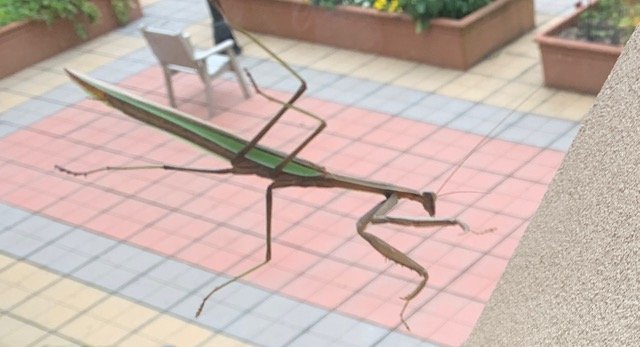Contributed by Cynthia Ferguson
Contributed by Barbara Bruno
Contributed by Simone
Contributed by Donald Butt

Contributed by Cynthia Ferguson

Contributed by Barbara Bruno

Contributed by Simone


Contributed by Donald Butt


Norma had to wonder if she had ever really fit in

Working with a coach was doing wonders for Courtney's balance

Woofy decided that painting was at least as much fun as chasing squirrels

The school year was challenging--and fun

Harkins took his favorite carousel horse out for a joyride
Art and photos by Jane Hart



Kendal’s community sports not one but two Alfredo Diaz-es! Father Alfredo Diaz is an integral part of the team that keeps Kendal running smoothly. Son Alfredo Diaz is an integral part of the team that keeps Kendal residents running smoothly out of our community, i.e. by driving us hither, thither, and yon. Our heartfelt thanks to both generations of Diaz!

Photo by Cathie Campbell

After the Storm
Photo by Greg Lozier

Ho-hum, just another Kendal sunset . . .
Photo by Philip Monteleoni

The Three Graces
Photo by Edward Kasinec

Profiles in Goat-age
Photo by Mimi Abramovitz

Don't Bother Me, I'm Busy
Photo by Mimi Abramovitz

A Praying Mantis on a window of the Fulton bridge, above the Terrace
Photo by Harry Bloomfeld

"I know we are in Sleepy Hollow, but is this a meeting of ghosts?"
Photo (and question) by Joe Bruno


Photos by Mimi Abramovitz

Photo by Edward Kasinec



Photos by Carolyn Reiss

Most contemporary newscasts run a line of text to accompany their reporting, a concept that traces back to New York City and the first news ticker. Known as the “the Zipper,” the Motograph News Bulletin used nearly 15,000 lightbulbs to transmit the latest directly to denizens of Times Square. Engineer Frank C. Reilly put the concept into reality, launching the ticker on November 6th, 1928. The first message? HOOVER DEFEATS AL SMITH.

Four trillion dollars are under hedge fund control these days, but a century ago they didn't exist. Benjamin Graham, an immigrant New Yorker overcoming an impoverished upbringing, came up with the concept when he founded the Graham–Newman Corp. in New York City in 1926. Credited with being behind the world's first hedge fund, Graham also made a name mentoring Warren Buffet and becoming known as the “father of value investing.”

Stately Wayne Manor is not the point of origin for Batman. Although he made many billions for Hollywood, the character's origins are with humble kids of immigrants in the Bronx. Bill Finger and Bob Kane introduced Batman to the world in Detective Comics #27 in the spring of 1939. By lore, Kane came up with the character from a bench in Poe Park, which sits alongside the final home of another famed Bronx resident, Edgar Allan Poe.
Source: “Made In NYC,” by Ethan Wolff, March 2024, City Guide New York
Contributed by Bobbie Roggemann

Astronomer Carl Sagan wrote in his 1980 book Cosmos that there were more stars in the universe than grains of sand on beaches on Earth—a statement that’s both wondrous and impossible to prove. But some scientists pondering similar ideas believe that there may be more trees on Earth than stars in the Milky Way galaxy.
The theory stems from a 2015 study that attempted to determine how many living trees could be found on the planet, by estimating the number of trees living in different environments. Tropical and subtropical forests appear to have 43% of the world’s tree population, nearly double that of frosty boreal forests found in places such as Canada, Russia, and Norway. Other regions, including the temperate biome (central Europe and the U.S. Northeast), generally have the fewest number of trees. The combined estimates per zone lead some scientists to believe that Earth is home to roughly 3 trillion trees. Compared to NASA’s estimate of more than 100 billion stars in the Milky Way, it appears that trees far outnumber the Milky Way’s sparkling orbs.
However, the scientific community acknowledges that we’ll likely never know the true number of stars in the sky or how many trees are rooted in the Earth, because there are too many factors at play. Astronomers can guess at the number of stars by observing how the galaxy rotates and calculating its mass, though not all stars are visible from Earth, and it’s impossible to count them individually to confirm the math. On Earth, humans cut down 15 billion trees annually but replace some, with an estimated 1.3 billion saplings produced in the U.S. each year in the hopes of balancing the count. After all, even if we have trillions of them, each tree on the planet is precious.
Most pine trees produce pine cones, the woodsy mechanisms through which they distribute their seeds. Some species, like North America’s eastern hemlock, produce tiny, half-inch seed pods. These pale in comparison to the Coulter pine’s pine cones, which max out at 11 pounds — the largest pine cones on Earth. Coulter pine cones grow over the course of two years and can reach up to 20 inches in length. They’re so large that they’re often nicknamed “widow-makers” because of the danger they present to people below. However, your chances of encountering a Coulter pine are relatively small, since the species — first recorded in 1831 — is not especially widespread. It’s native to the mountains of Southern California and northwestern Mexico, where the trees grow along ridges and dry, rocky slopes.
Source: interestingfacts.com
Contributed by Jane Hart

Got Teenagers? Got Nerve? Experience Thrills and Chills at the Sleepy Hollow Haunted Hayride!

Climb aboard the Sleepy Hollow Haunted Hayride and hold on to your head! All seems well when you board your hay wagon in the brightly lit streets of downtown Sleepy Hollow. The journey begins innocently enough. Rumbling off into the dark you realize too late you are heading down the Albany Post Road past the Old Dutch Church, following exactly Ichabod Crane’s flight from the Headless Horseman. Then you’re through a set of iron gates and the wagon slips into the dark woods of the hollow. Clattering across a wooden bridge, you start to hear shrieks and the sound of hoofbeats . . .
There’s a free block party on Beekman Avenue both nights to keep you entertained before your hair-raising ride through the real Sleepy Hollow. If you keep your head, you’re welcome to come back for more live music, entertainment, family activities and vendors!
Where: Sleepy Hollow Village Hall, 28 Beekman Avenue, Sleepy Hollow, NY When: October 18 and 19. Block party begins at 5 pm, hayride begins at 7 pm.
Ticket sales are online only and on-sale now. Tickets to the Sleepy Hollow haunted hayride are timed entry and specific to either Friday or Saturday night. Secure your spot early! Tickets sell fast for this popular Halloween event.
Please be careful when selecting your dates and times, as all purchases will be FINAL and there will be NO REFUNDS (unless the event is cancelled by the Village).
Also, please note it and is not recommended for some children due to its SCARY and GRAPHIC content. Ultimately, use parent discretion to decide whether the ride is suitable for your child or not...as you know your child best.

Contributed by Barbara Bruno

Contributed by Donald Butt



Contributed by Barbara Bruno





The Beacon Theatre was packed for Alvin and the Chipmunks’ Farewell Tour

Marlie, a nearsighted birdwatcher, was grateful for the closeup

The bubble pipe gave Woofy gravitas

Mega-influencer Platz brought lost glamour to the struggling Meow Mix brand

No, Bryce didn’t want to race Elizabeth to school at 5:00 am.
Art and photos by Jane Hart

Jean MacIntosh shared stories from more than 100 years
Photo by Harry Bloomfeld

And the audience was rapt
Photo by Philip Monteleoni

Photo by Edward Kasinec
One morning, as she was walking in the park, Carolyn Reiss encountered a leaf tethered to a very long spider thread dancing in the wind like a kite, twisting and turning.


Photos by Carolyn Reiss

Photo by Carolyn Reiss

Photo by Edward Kasinec

Not a huge surprise that this is a New York invention, although you might have thought it was an old country import first. In fact, the original Jewish deli was started by the Iceland Brothers on the Lower East Side in 1888. Willy Katz joined the restaurant in 1903 and bought out the Iceland Brothers with his cousin Benny in 1910. Today you can find Jewish delis from coast to coast, in locations as random as Indianapolis, Beverly Hills, and Orlando.

New York City gets credit for 3 innovations in the birth of coffee making its way into homes, offices, and hotel suites:
1. During the early years of the Civil War, NYC’s Lewis Osborn created Osborn’s Celebrated Prepared Java Coffee, the first ground, prepared, and packaged coffee in world history. Although it did not give the market a major jolt (the bulky pail it was distributed in probably didn’t help), it opened the door for bigger operations.
2. In 1862, the first factory in the US to make bags for loose coffee began operations in Brooklyn.
3. The big win, however, belonged to John Arbuckle and his brother Charles. They founded the Arbuckle Brothers Company in New York City in 1871 and became the first merchants to sell packaged coffee. (The coffee itself went nationwide, sold under the Ariosa brand and becoming popular enough on the frontier to be branded “The Coffee that won the West.”)

Over 100 million Twizzlers are sold every year in the US, and it’s a $3,000,000,000 business globally, but the origins of the candy are small-town NYC. Two Brooklyn businesses combined forces in 1845 and sold whips and other licorice confections as Young & Smylie. They didn’t pick up the Twizzler name until after later mergers and consolidations; that licorice brand has been around since 1929.
Source: “Made In NYC,” by Ethan Wolff, March 2024, City Guide New York
Contributed by Bobbie Roggemann
Carolyn Reiss reports that this summer she went to visit her friend Flora on Harvey’s Lake, PA. This turns out to be near Tunkhannock, the home town of Debbie Bell— and in the middle of nowhere.
Heads up: Carolyn advises that anyone going West or back East on 84 near Port Jervis who likes homemade reasonably priced ice cream in various flavors and concoctions, along with other homemade quick foods and a picnic spot on the Delaware 1 mile off the highway, should stop at Riverside Creamery.
Though ice cream and such was clearly one of the hits of the trip, so was the beauty of the area.

Old steel bridge over the Delaware River

Hiking the waterfall trail in Ricketts Glen State Park

Boating on the lake with both dogs, and Flora at the helm

Dietrich Theater sports a mural of the famous Nicholson Bridge (aka the Lackawanna Viaduct) near Tunkhannock

No one likes hiccups. Luckily, these involuntary spasmodic interruptions usually last only a few minutes. On rare occasions, hiccups persist for a few days, and even more rarely still they persist for longer than a month (in which case they can be considered “intractable”). Then there’s the strange case of Charles Osborne, who was afflicted with a continuous case of hiccups for 68 years — recognized by Guinness World Records as the longest case of hiccups in history.
Osborne’s story began with an accident on June 13, 1922, in which he accidentally slipped and fell. His doctor later said he popped a blood vessel in his brain the size of a pin, and theorized that Osborne must have damaged the incredibly small area of the brain that controls and inhibits hiccups.
Osborne’s diaphragm spasmed 20 to 40 times a minute, on average, during his waking hours — meaning he hiccuped roughly 430 million times throughout his life. To cope with this never-before-seen disorder, Osborne learned breathing techniques that effectively masked his constant hiccuping. Later in life, Osborne appeared in magazines and on late-night television shows to talk about his ailment.
In 1978, Osborne told the Associated Press that he’d “give everything I got in the world if I could get rid of them.” Although he traveled the world in search of a cure — even offering $10,000 to anyone who could find one — the best he could do was cope with the affliction. Finally, in 1990, his diaphragm suddenly ended its 68-year-long spasmodic episode on its own. Sadly, Osborne died less than a year later, but he was at least able to experience the final days of his life sans hiccups.
Source: interesting facts.com
Contributed by Jane Hart

Contributed by Jane Hart

Contributed by Barbara Bruno



Contributed by Donald Butt

Contributed by Simone

The last day of summer camp was poignant for Seth and Lauren, but they promised to email every day

The Swinton-Rueful residence was small, even for a tiny home, but the leaded window reminded Sissy of Downtown Abbey

It had taken Marty all summer to grow his full-body Mohawk, but he was ready for the first day of school

Delilah said the date was off unless he got a haircut

A touch of Fall in the air was bracing
Art and photos by Jane Hart


Photo by Philip Monteleoni


Photos by Mimi Abramovitz

Illumined pathway

Afternoon of a fawn
Photos by Edward Kasinec

Visit of a Monarch
Photo by Harry Bloomfeld

Each month, the Village of Sleepy Hollow puts out an online newsletter—Sleepy Hollow Connected—that outlines pertinent issues and happenings for the coming month.
You can also sign up for the newsletter to be sent each month to your email.
© Kendal on Hudson Residents Association 2015, 2016, 2017, 2018, 2019, 2020, 2021, 2022 all rights reserved. Please do not reproduce without permission.
Photographs of life at Kendal on Hudson are by residents.